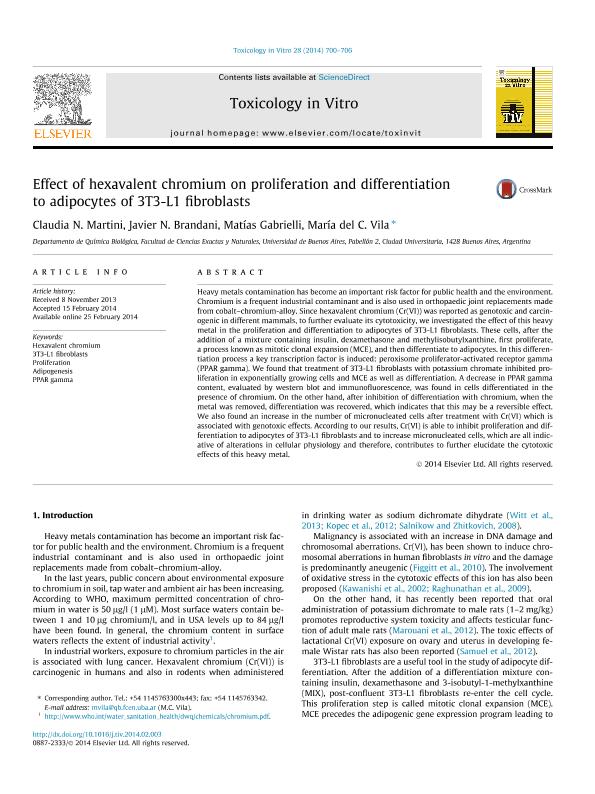Mostrar el registro sencillo del ítem
dc.contributor.author
Martini, Claudia Noemí

dc.contributor.author
Brandani, Javier Nahuel

dc.contributor.author
Gabrielli, Matias

dc.contributor.author
Vila, Maria del Carmen

dc.date.available
2017-12-13T15:35:49Z
dc.date.issued
2014-02
dc.identifier.citation
Martini, Claudia Noemí; Brandani, Javier Nahuel; Gabrielli, Matias; Vila, Maria del Carmen; Effect of hexavalent chromium on proliferation and differentiation to adipocytes of 3T3-L1 fibroblasts; Elsevier; Toxicology in Vitro; 28; 4; 2-2014; 700-706
dc.identifier.issn
0887-2333
dc.identifier.uri
http://hdl.handle.net/11336/30397
dc.description.abstract
Heavy metals contamination has become an important risk factor for public health and the environment. Chromium is a frequent industrial contaminant and is also used in orthopaedic joint replacements made from cobalt–chromium-alloy. Since hexavalent chromium (Cr(VI)) was reported as genotoxic and carcinogenic in different mammals, to further evaluate its cytotoxicity, we investigated the effect of this heavy metal in the proliferation and differentiation to adipocytes of 3T3-L1 fibroblasts. These cells, after the addition of a mixture containing insulin, dexamethasone and methylisobutylxanthine, first proliferate, a process known as mitotic clonal expansion (MCE), and then differentiate to adipocytes. In this differentiation process a key transcription factor is induced: peroxisome proliferator-activated receptor gamma (PPAR gamma). We found that treatment of 3T3-L1 fibroblasts with potassium chromate inhibited proliferation in exponentially growing cells and MCE as well as differentiation. A decrease in PPAR gamma content, evaluated by western blot and immunofluorescence, was found in cells differentiated in the presence of chromium. On the other hand, after inhibition of differentiation with chromium, when the metal was removed, differentiation was recovered, which indicates that this may be a reversible effect. We also found an increase in the number of micronucleated cells after treatment with Cr(VI) which is associated with genotoxic effects. According to our results, Cr(VI) is able to inhibit proliferation and differentiation to adipocytes of 3T3-L1 fibroblasts and to increase micronucleated cells, which are all indicative of alterations in cellular physiology and therefore, contributes to further elucidate the cytotoxic effects of this heavy metal.
dc.format
application/pdf
dc.language.iso
eng
dc.publisher
Elsevier

dc.rights
info:eu-repo/semantics/openAccess
dc.rights.uri
https://creativecommons.org/licenses/by-nc-nd/2.5/ar/
dc.subject
Hexavalent Chromium
dc.subject
3t3-L1 Fibroblasts
dc.subject
Proliferation
dc.subject
Adipogenesis
dc.subject
Ppar Gamma
dc.subject.classification
Toxicología

dc.subject.classification
Medicina Básica

dc.subject.classification
CIENCIAS MÉDICAS Y DE LA SALUD

dc.title
Effect of hexavalent chromium on proliferation and differentiation to adipocytes of 3T3-L1 fibroblasts
dc.type
info:eu-repo/semantics/article
dc.type
info:ar-repo/semantics/artículo
dc.type
info:eu-repo/semantics/publishedVersion
dc.date.updated
2017-12-12T18:51:08Z
dc.journal.volume
28
dc.journal.number
4
dc.journal.pagination
700-706
dc.journal.pais
Países Bajos

dc.journal.ciudad
Amsterdam
dc.description.fil
Fil: Martini, Claudia Noemí. Universidad de Buenos Aires. Facultad de Ciencias Exactas y Naturales. Departamento de Química Biológica; Argentina. Consejo Nacional de Investigaciones Científicas y Técnicas; Argentina
dc.description.fil
Fil: Brandani, Javier Nahuel. Universidad de Buenos Aires. Facultad de Ciencias Exactas y Naturales. Departamento de Química Biológica; Argentina. Consejo Nacional de Investigaciones Científicas y Técnicas; Argentina
dc.description.fil
Fil: Gabrielli, Matias. Universidad de Buenos Aires. Facultad de Ciencias Exactas y Naturales. Departamento de Química Biológica; Argentina. Consejo Nacional de Investigaciones Científicas y Técnicas; Argentina
dc.description.fil
Fil: Vila, Maria del Carmen. Universidad de Buenos Aires. Facultad de Ciencias Exactas y Naturales. Departamento de Química Biológica; Argentina. Consejo Nacional de Investigaciones Científicas y Técnicas; Argentina
dc.journal.title
Toxicology in Vitro

dc.relation.alternativeid
info:eu-repo/semantics/altIdentifier/doi/http://dx.doi.org/10.1016/j.tiv.2014.02.003
dc.relation.alternativeid
info:eu-repo/semantics/altIdentifier/url/http://www.sciencedirect.com/science/article/pii/S0887233314000289
Archivos asociados
